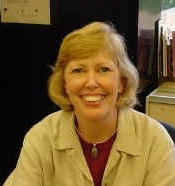WAC/CAC in Secondary Schools: Taking Risks Across the Curriculum
 Pamela B. Childers, Secondary School Issues Editor
Pamela B. Childers, Secondary School Issues Editor
Home Page: http://www.mccallie.org/pchilder/
Email: pchilder@mccallie.org
When I was returning from spring break, I happened to fly back to Chattanooga in the same row with a colleague in the science department. He was returning from the National Science Teachers Association (NSTA) annual convention in San Diego. Full of enthusiasm, Michael said, "I had forgotten how stimulating conferences can be if you just get out of your comfort zone and take the risk of learning from other teachers in schools very different from your own."
I thought to myself how right he was. So many of our colleagues go to conferences without knowing how to "read" the programs to determine the best sessions to attend. They go with a teacher from their own school and spend their time going to the same few functions, visiting the exhibit areas and sightseeing or attending a sporting event. Don't get me wrong; I love the exhibit areas and will never forget seeing Cal Ripken hit his 3,000th hit in the Minneapolis HHH Metrodome with several of my writing center buddies! However, we had also spent the day attending different sessions, working in the writing center booth, and attending Special Interest Group sessions for WAC and IWCA (International Writing Centers Association). But then, none of these people had come from my school; in fact, most of them don't even teach on the same level that I do. How could I possibly learn anything to apply to my own teaching?
I realized how the valuable risk taking I have done for years at conferences has now become my comfort zone. I used to attend just the NCTE annual convention until a college friend invited me to be on a panel at CCCC in the 1980s. I was a little intimidated (no, very intimidated), thinking about being one of the only secondary school teachers attending this conference directed at college people. In some ways, I still have people attempt to intimidate me with their "status" as a college instructor, but I now have enough experience to realize they are just showing their inexperience. But I enjoy learning from colleagues teaching at other academic levels in ways that I overlooked at first. Secondary teachers have much to learn from their colleagues in higher education; mainly, we learn what our students can expect when they get to college and how we can best prepare them to become better writers, thinkers, and learners. Just as important, college instructors can learn how to collaborate with secondary teachers and how their students have been prepared for college-level work. Also, both can learn how to become better teachers and learners. Hanging around with only secondary English teachers will give me great ideas and feedback; but when I step out of that comfort zone into one with college colleagues, I get a different perspective that is vital to my profession, too. Because we learn from one another, we can apply what we learn to our own teaching environment. For me, this concept works with WAC and IWCA conferences as well.
There is also the tremendous opportunity offered for exchange of ideas vertically at the AP Language and AP Literature (www.collegeboard.org/ap) exam readings each June. Who would believe that after reading thousands of papers in one week that college and secondary teachers could spend their lunch hours and evenings exchanging ideas for classroom activities, lists of books to read, and curricular concerns. It is never enough to spend all day talking about writing with other teachers! Also, the poetry and prose readings, and the book display area exhibiting books written by those who are reading the exams offer more opportunities for learning. Sure, some choose to go directly to their rooms or the pool after dinner, but those are not the risk takers.
What if we extend this idea horizontally as well as vertically? My colleague in science has been selected for NEH seminars (www.neh.gov) on Plato in Greece and another on Mozart in Vienna. Imagine what that information has added to his teaching of physics and to his choice of writing assignments. Based on my own risk taking in the areas of visual arts and writing (ARTiculating: Teaching Writing in a Visual World) and in the relationship between music and writing ("The Art of Composing: Writing, Music, Visual Media"), I applied for an NEH institute on Opera, Giving Voice to Culture. Believe me, this is a risk far beyond my wildest imaginings, as I spend a month studying Pushkin's novel and Tchaikovsky's opera Eugene Onegin. My learning curve will be skyrocketing this summer!
What if I attend conferences for other disciplines? Imagine what I could learn there to apply to writing and communication across the curriculum! Now that I've admitted to my former risks have become my comfort zone, it's time to take some greater risks, and I challenge you to do the same. I cornered Michael two days later, and we have written a proposal for the 2003 NSTA (www.nsta.org) convention, as well as one on science and writing centers for CCCC 2003 (www.ncte.org). Whether we are invited to present or not, I am going. Maybe next year I will plan for the 2004 National Mathematics Teachers Association (www.nmta.org) convention or one for history teachers. Hmm, there's art and music, too!
Works Cited
Childers, Pamela B., Eric Hobson and Joan Mullin. ARTiculating: Teaching Writing in a Visual World. Portsmouth, NH: Boynton/Cook, 1998.
Stay, Byron, Pamela B. Childers, Claire Marie Moblard-Stay, and Malcolm G. Childers. The Art of Composing: Writing, Music, Visual Media. International Writing Centers Association Conference. 11 Apr. 2002. Savannah.
Publication Information: Childers, Pamela B. (2002). WAC/CAC in secondary schools: Taking risks across the curriculum. Academic.Writing, https://doi.org/10.37514/AWR-J.2002.3.1.05
Publication Date: May 7, 2002
DOI: 10.37514/AWR-J.2002.3.1.05
Copyright © 2002 Academic.Writing.